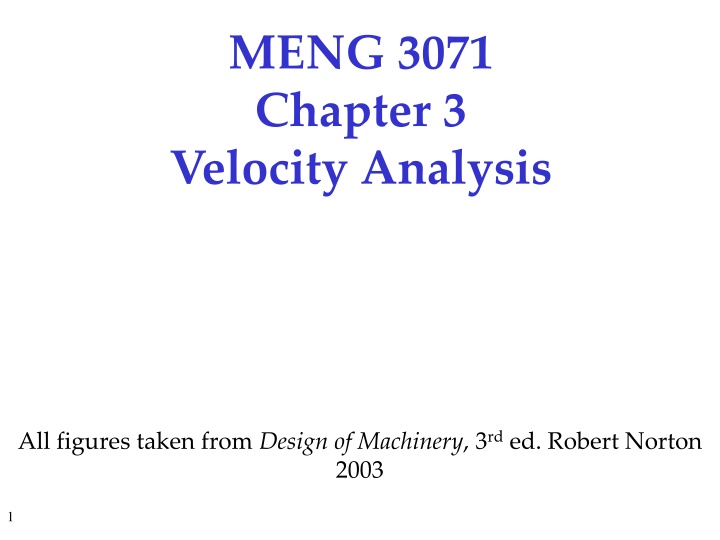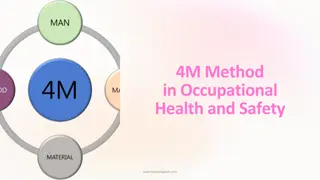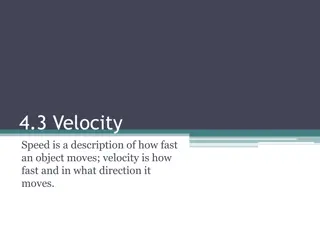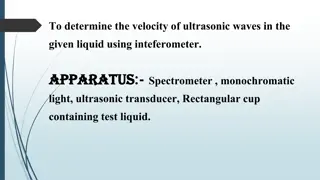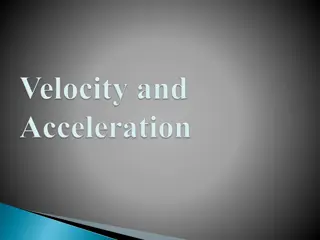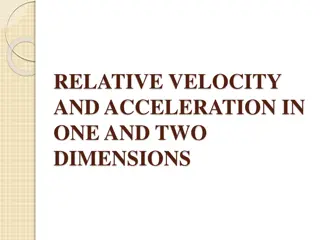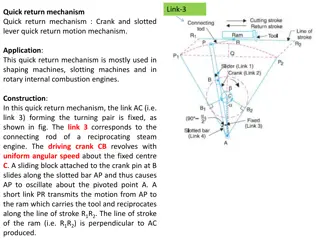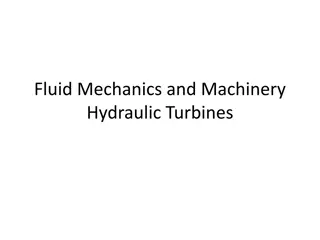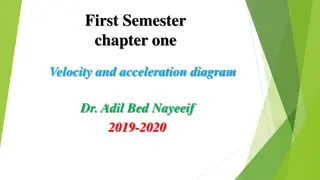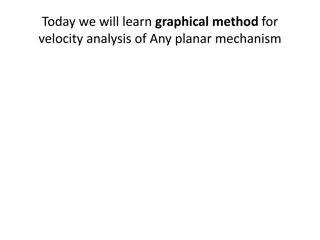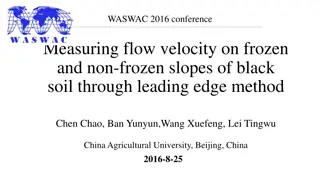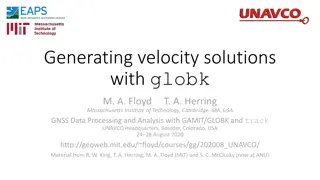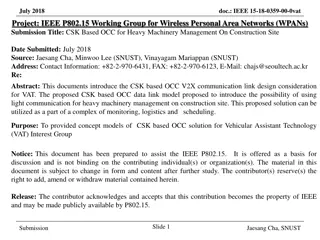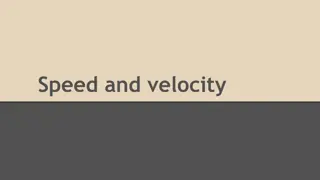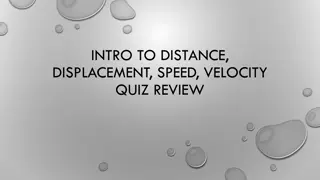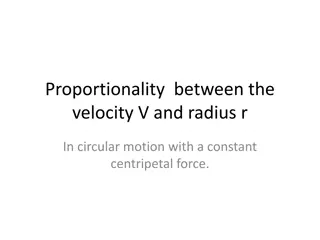Velocity Analysis in Machinery Design
In this study, the analysis of linear and angular velocities in machinery design is explored. Definitions, graphical solutions, and the concept of instant centers are discussed with visual aids. Kennedy's rule for determining instant centers among various links is also explained.
Download Presentation

Please find below an Image/Link to download the presentation.
The content on the website is provided AS IS for your information and personal use only. It may not be sold, licensed, or shared on other websites without obtaining consent from the author.If you encounter any issues during the download, it is possible that the publisher has removed the file from their server.
You are allowed to download the files provided on this website for personal or commercial use, subject to the condition that they are used lawfully. All files are the property of their respective owners.
The content on the website is provided AS IS for your information and personal use only. It may not be sold, licensed, or shared on other websites without obtaining consent from the author.
E N D
Presentation Transcript
MENG 3071 Chapter 3 Velocity Analysis All figures taken from Design of Machinery, 3rd ed. Robert Norton 2003 1
Velocity Analysis Definitions Linear Velocity d R = = V R dt dt d Angular Velocity = = Velocity of a point Link in pure rotation i = R pe Multiplying by i rotates the vector by 90 PA = = V V R Velocity is perpendicular to radius of rotation & tangent to path of motion PA P PA ( ) i ( ) i i = = i pe pe 2
Velocity Analysis Vector r can be written as: Imaginary i = + cos sin re r i cos r Multiplying by i gives: i = + sin cos ire r i r Multiplying by i rotates a vector 90 sin r Real cos r sin r 3
Velocity Analysis If point A is moving V V V A P + = = + PA ( ) i i V pe A Graphical solution: 4
Graphical Velocity Analysis (3 & 4) Given linkage configuration & 2. Find 3 and 4 We know VA and direction of VB and VBA (perpendicular to AB) Draw vector triangle. V= r. VBA Direction VBA VA VBA VB VB VB Direction ( O B ) ) = V AB 3 BA ( = V 4 4 B 5
Graphical Velocity Analysis (VC) After finding 3 and 4, find VC VC=VA+VCA Recall that 3 was in the opposite direction as 2 Double Scale VC VCA VA VCA VC 6
Instant Center A point common to two bodies in plane motion, which has the same instantaneous velocity in each body. In ENGR 214 we found the instant center between links 1 and 3 (point on link 3 with no velocity) Now we also have an instant center between links 2 and 4 7
Instant Centers Kennedy s rule: any three links will have three instant centers and they will lie on a straight line The pins are instant centers I13 is from links 1,2,3 and 1,3,4 I24 is from links 1,2,4 and 2,3,4 1 2 3 1 3 4 1 2 4 2 3 4 I13 Links I12 I24 I14 I23 I34 I24 I12 I23 I13 I13 I34 I14 IC s I24 8
Instant Centers I13 has zero velocity since link 1 is ground 3 is the same all over link 3 Velocity relative to ground=r , perpendicular to r VA2=a 2=VA3=p 3 From this, 3 must be in the opposite direction as 2, and smaller in magnitude since p>a I13 3 p VA2 3 A VA3 a 9
Instant Centers I24 has the same velocity on link 2 and link 4 VI2=l2 2=VI4=l4 4 From this, 4 is in the same direction as 2 and smaller in magnitude since l4>l2 4 l4 I24 VI4 l2 VI2 10
Instant Centers Practice Problems A B O4 O2 Power=Tin in=Tout out A O4 O2 11 B
Velocity Analysis of a 4-Bar Linkage Given 2. Find 3and 4 12
Velocity Analysis of a 4-Bar Linkage Write the vector loop equation + ce be ae i i i i = 0 de 3 2 4 1 After solving the position analysis, take the derivative ( 2 + i be i ae + be i ae i ) i ( ) ( ) 0 = i i i i i ce 3 2 4 3 i 4 i = 0 ce 3 2 4 2 3 4 or V i = i = V ae 2 2 A + = 0 V V i A BA B i V be 3 3 BA V where i = i ce 4 4 B 13
Velocity Analysis of a 4-Bar Linkage ce i be i ae i i i i + = 0 3 2 4 2 3 4 Take knowns to one side: ce be i i i = ae 3 4 2 3 4 2 Take conjugate to get 2nd equation: ce be i i i = ae i 3 4 2 3 4 2 i i ae be ce Put in matrix form: 2 3 4 3 2 = i i i ae be ce 2 3 4 4 2 1 i i i ae be ce Invert matrix: 2 3 4 3 2 = i i i ae be ce 2 3 4 4 2 14
Inverted Crank Slider Link 3 is a slider link: its effective length, b, changes b Given 2. Find 3 and 15
Inverted Crank Slider Given 2. Find 3 and Write the vector loop equation: ce be ae b i i i i = 0 de 3 2 4 1 After solving the position analysis, take the derivative: i e b ae i i i i i i = 0 be ce 3 3 2 4 2 3 4 To get another equation: + = 4 3 i e b + or = i be + ( ) 3 4 i i so i = i ce ae 3 3 4 2 3 2 16
Inverted Crank Slider ) i ce be = + ( i i i i b + i e ae 3 3 4 2 3 2 Take conjugate to get second equation: ( 3 be i e b ) i i i i + = i ce ae 3 3 4 2 2 Put in matrix form: ( ( be i e ) i i i i b i + ae e i be ce 2 3 3 4 2 ) = i i i i i + ae ce 2 ) i 3 3 4 3 2 ( ( be 1 i i i i b i + ae e i be ce 2 3 3 4 Invert: 2 ) = i i i i + ae e i ce 2 3 3 4 3 2 17
Velocity of any Point on a Linkage Write the vector for RP = p ae R ( ) + i i + pe 3 3 2 Take the derivative = p ae i V ( ) + i i + i pe 3 3 2 2 3 Similarly ( + ) 2 ( i i = = R V se i 2 S RP ) + se 2 2 2 S ( + ) 4 ( i i = = R V ue i 4 U ) + ue 4 4 4 U 18
Offset Crank Slider Given 2. Find 3 and d b c a 19
